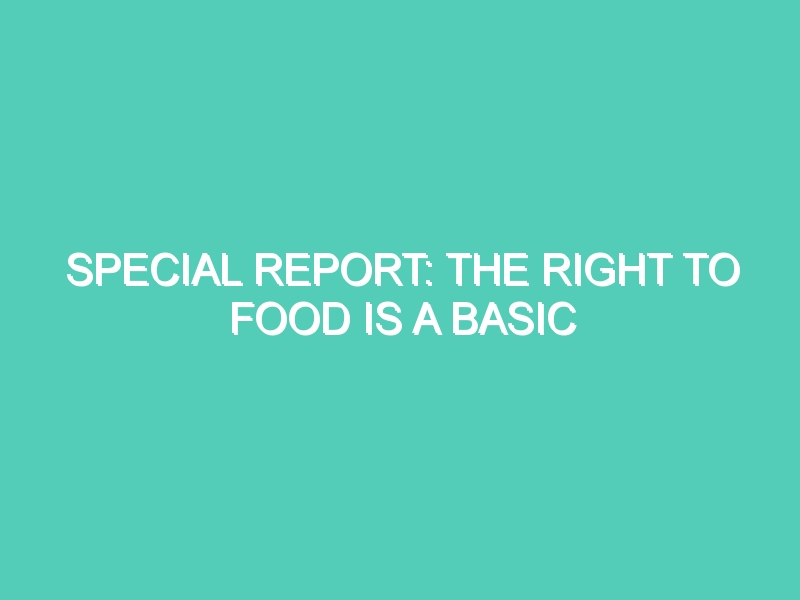This is a special Hunger Notes report on the right to food. Why shouldn’t people have enough food, earned in the usual case by working, to keep themselves alive and alert? A very reasonable goal, but one which is far from being met, though there has been significant progress in the past 10 years. This report examines both the progress and the frustrations.
It is divided into the following sections.
- the human right to food
- the human right to food in developing countries
- the human right to food in the United States
- updates
- 1998 articles
The Human Right to Food
Ellen Messer and Marc Cohen in the first section of their article US Approaches to Food and Nutrition Rights, 1976-2008 provide a succinct introduction to the development of the human right to food in the United Nations system. This is a fascinating history.
The human right to food has its contemporary origin within the U.N. Universal Human Rights framework. The main reference point is located within the Universal Declaration of Human Rights (UDHR) (U.N. 1948), Article 25, which states, “Everyone has the right to a standard of living adequate for the health and well-being of himself and his family, including food.” It provided a reference point for human rights legislation that followed but is not itself a binding international legal instrument.1
The modern human rights framework for a specific right essentially consists of a legal framework in a country that establishes something as a right, including an effective procedure for enforcing the right, a process for adjudicating individual rights cases (which can involve different interpretations of the legal framework), and resources provided to address the outcome of rights decisions. In the United States two good examples would be the right to bear arms or the right to asylum. There is a legal code that defines the right, has the ability to actually influence outcomes, a procedure for adjudicating different definitions, and money provided to facilitate the process and outcomes. In the case of asylum for example, United States has provided various legal reasons permitting asylum in the United States for various groups, a process for adjudicating disputes, and billions of dollars to permit and facilitate this asylum.
What has evolved has been progressive implementation of the right to food.
Asbjørn Eide in The human right to food and contemporary globalization explores the fundamental reason why current globalization efforts have been opposed by so many: globalization in its initial formulation meant concern for poor and oppressed people thoughout the world, and not just reducing the barriers to trade and corporate investment.
Wenche Barth Eide and Uwe Kracht in Challenges ahead for the human right to food discuss official responses to the world food crisis, which have paid only slight attention to the human right to food, and briefly discuss next steps.
Arne Oshaug in Progress in reducing hunger after the World Food Summit discusses two main global initiatives to reduce hunger:
- the World Food Summit (WFS), its commitments, and follow up
- the Millennium development goals and their follow up
Both the World Food Summit and the Millennium development goals recognize the importance of food to alleviate hunger and its importance to human beings, though not addressing it in the context of a legal right. However, as major international efforts–if major international effort is not an oxymoron–they can facilitate the human right to food. Oshaug points out
- the failure to meet the WFS hunger reduction goals
- the declining practical importance of achieving these goals (even for the FAO, that convened the WFS),
- the replacement of the WFS goal by the lesser Millennium development goal and the degree to which this goal is being achieved
The Human Right to Food in developing countries
The right to food has been gaining in developing countries. Right to food advocates recognize that the right to food cannot be achieved overnight in developing countries. Thus advocates–and the emerging legal framework–place great importance on two concepts–progressive implementation and voluntary guidelines.
Brazil has been a leader in implementing the right to food. Patrus Ananias in Implementing the human right to food in Brazil describes the progress that Brazil has made and the key components of its advances.
FIAN has been in the forefront of examining country polices in light of the human right to food. Specific country studies include
- Guatemala Women’s right to food in Guatemala
- Nicaragua. Parallel report: the right to food and the struggle against hunger in Nicaragua: one year of the Zero Hunger Program
- Philippines Parallel report: the right to adequate food in the Philippines
- Zambia The right to food of milk and honey farmers, Zambia
The FAO right to food page provides much useful information on right to food developments. The front page provides a summary of recent developments as well as links to further information on FAO efforts. There is also a valuable on-line right to food course.



